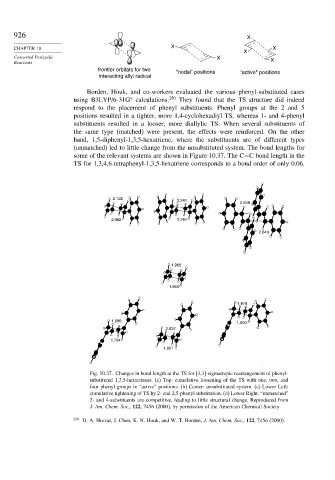Page 942 - Advanced Organic Chemistry Part A - Structure and Mechanisms, 5th ed (2007) - Carey _ Sundberg
P. 942
926 X
X
CHAPTER 10 X
X
Concerted Pericyclic X
Reactions X
frontier orbitals for two "nodal" positions "active" positions
interacting allyl radical
Borden, Houk, and co-workers evaluated the various phenyl-substituted cases
using B3LYP/6-31G calculations. 250 They found that the TS structure did indeed
∗
respond to the placement of phenyl substituents. Phenyl groups at the 2 and 5
positions resulted in a tighter, more 1,4-cyclohexadiyl TS, whereas 1- and 4-phenyl
substituents resulted in a looser, more diallylic TS. When several substituents of
the same type (matched) were present, the effects were reinforced. On the other
hand, 1,5-diphenyl-1,3,5-hexatriene, where the substituents are of different types
(unmatched) led to little change from the unsubstituted system. The bond lengths for
some of the relevant systems are shown in Figure 10.37. The C−C bond length in the
TS for 1,3,4,6-tetraphenyl-1,3,5-hexatriene corresponds to a bond order of only 0.06.
2.122
2.241
2.649
2.062 2.241
2.649
1.965
1.965
1.979
1.680
1.900
1.837
1.794
1.821
Fig. 10.37. Changes in bond length at the TS for [3,3]-sigmatropic rearrangement of phenyl-
substituted 1,3,5-hexatrienes. (a) Top: cumulative loosening of the TS with one, two, and
four phenyl groups in “active” positions. (b) Center: unsubstituted system. (c) Lower Left:
cumulative tightening of TS by 2- and 2,5-phenyl substitution. (d) Lower Right. “unmatched”
2- and 4-substituents are competitive, leading to little structural change. Reproduced from
J. Am. Chem. Soc., 122, 7456 (2000), by permission of the American Chemical Society.
250
D. A. Hrovat, J. Chen, K. N. Houk, and W. T. Borden, J. Am. Chem. Soc., 122, 7456 (2000).

